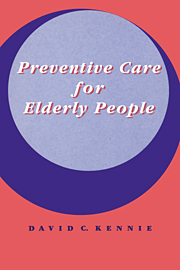Book contents
- Frontmatter
- Contents
- Acknowledgements
- 1 An overall perspective
- 2 What is health in old age?
- 3 The goals of health promotion for elderly people
- 4 A task for everyone
- 5 Critique of strategies
- 6 Cancer prevention
- 7 The prevention of non-cancerous health problems
- 8 Enhancing functional status
- 9 Strengthening support systems
- 10 Summary of problems and strategies
- 11 Tailoring strategies to individuals
- 12 Targeting, screening and surveillance in primary care
- 13 Practical aspects of implementation
- 14 The costs of preventive care and health promotion
- Index
7 - The prevention of non-cancerous health problems
Published online by Cambridge University Press: 15 October 2009
- Frontmatter
- Contents
- Acknowledgements
- 1 An overall perspective
- 2 What is health in old age?
- 3 The goals of health promotion for elderly people
- 4 A task for everyone
- 5 Critique of strategies
- 6 Cancer prevention
- 7 The prevention of non-cancerous health problems
- 8 Enhancing functional status
- 9 Strengthening support systems
- 10 Summary of problems and strategies
- 11 Tailoring strategies to individuals
- 12 Targeting, screening and surveillance in primary care
- 13 Practical aspects of implementation
- 14 The costs of preventive care and health promotion
- Index
Summary
Hypertension
Importance
Although some studies have shown a lack of association between hypertension and mortality in elderly people and two have even shown an unexpected survival advantage, the considerable bulk of evidence indicates that hypertension is not a benign accompaniment of ageing. It is associated with greater mortality and morbidity from stroke and cardiovascular disease. Cardiovascular risk gradients actually increase with advancing age (see Fig. 7.1). Diastolic blood pressure is a predictor of risk in its own right but systolic pressure is equally, if not more, predictive of risk for cardiovascular morbidity and mortality and for future stroke events.
Prevalence estimates of both diastolic and isolated systolic hypertension in elderly people vary widely, tending to decrease with increasing numbers or occasions on which the blood pressure is measured prior to making the diagnosis. Between ages 60 to 70 years, the prevalence of elevated levels of combined casual systolic and diastolic pressure (upon which risk estimates may be based) range between 17 and 24 per cent. However, the prevalence of sustained levels for systolic and diastolic hypertension (upon which treatment decisions should be based) is about a third of this.
- Type
- Chapter
- Information
- Preventive Care for Elderly People , pp. 77 - 170Publisher: Cambridge University PressPrint publication year: 1993



